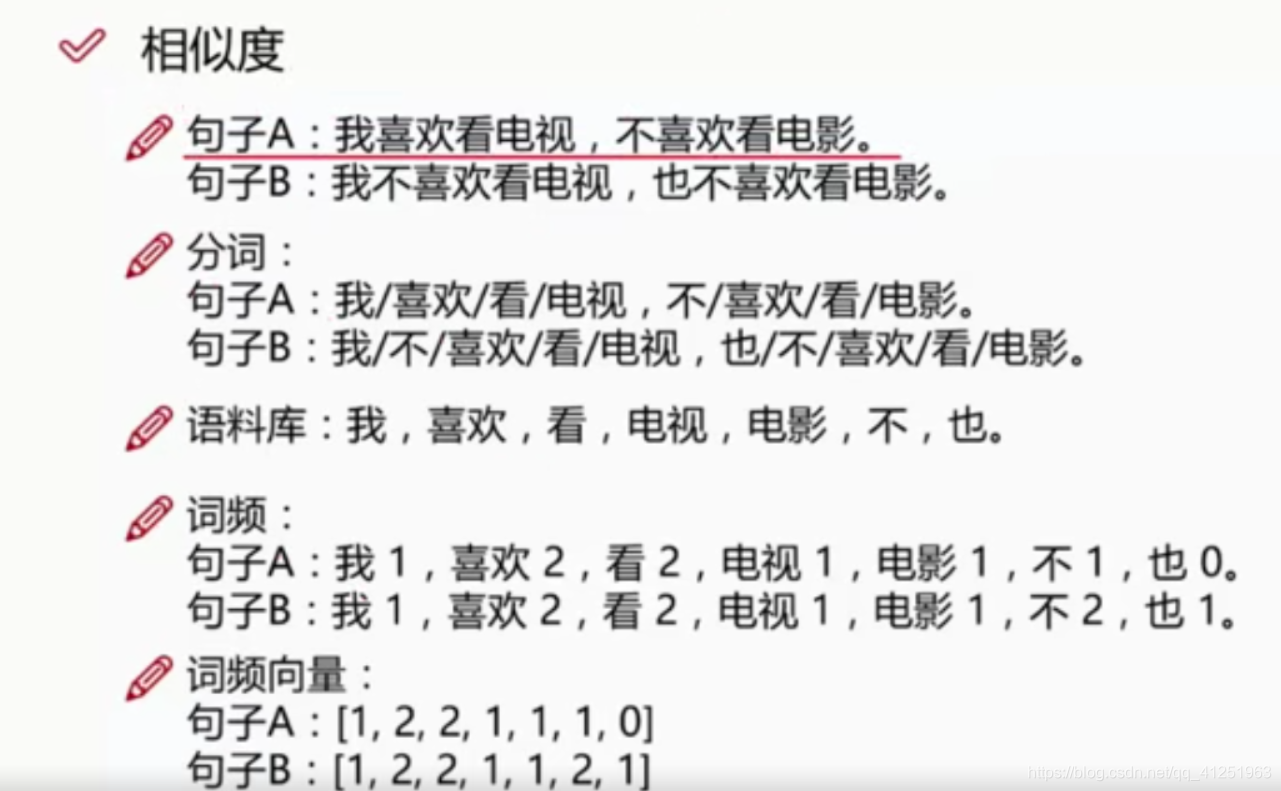逆文档频率(Inverse Document Frequency缩写为IDF)
如果某个词比较少,但是它在这篇文章中多次出现,那么它可能就反映了这篇文章的特性正是我们需要的关键词
词频(TF)=某个词在文章中的出现次数 / 该文出现次数最多的词出现的次数
逆文档频率(IDF)=log(语料库的文档总数 / 包含该词的文档数+1)
TF-IDF:关键词提取
TF-IDF=词频(TF)X 逆文档频率(IDF)

数据源:http://www.sogou.com/labs/resource/ca.php

import pandas as pd
import jieba
df_news=pd.read_table('data/val.txt',names=['category','theme','URL','content'],encoding='utf-8')
df_news=df_news.dropna()
print(df_news.head())

分词:使用结巴分词器
content=df_news.content.values.tolist()
print(content[1000])
![]()
content_S=[]
for line in content:
current_segment=jieba.lcut(line)
if len(current_segment)>1 and current_segment !='r\n':
content_S.append(current_segment)
print(content_S[1000])
![]()
df_content=pd.DataFrame({'content_S':content_S})
print(df_content.head())

stopwords=pd.read_csv("stopwords.txt",index_col=False,sep='\t',quoting=3,names=['stopword'],encoding='utf-8')
print(stopwords.head())

def drop_stopwords(contents,stopwords):
contents_clean=[]
all_words=[]
for line in contents:
line_clean=[]
for word in line:
if word in stopwords:
continue
line_clean.append(word)
all_words.append(str(word))
contents_clean.append(line_clean)
return contents_clean,all_words
contents=df_content.content_S.values.tolist()
stopwords=stopwords.stopword.values.tolist()
contents_clean,all_words=drop_stopwords(contents,stopwords)
df_content=pd.DataFrame({'contents_clean':contents_clean})
print(df_content.head())

df_all_words=pd.DataFrame({'all_words':all_words})
print(df_all_words.head())

words_count=df_all_words.groupby(by=['all_words'])['all_words'].agg({'count':numpy.size})
words_count=words_count.reset_index().sort_values(by=["count"],ascending=False)
print(words_count.head())

画出词云图
from wordcloud import WordCloud
import matplotlib.pyplot as plt
import matplotlib
matplotlib.rcParams['figure.figsize']=(10.0,5.0)
wordcloud=WordCloud(font_path="./data/simhei.ttf",background_color='white',max_font_size=80)
word_frequence={x[0]:x[1] for x in words_count.head(100).values}
wordcloud=wordcloud.fit_words(word_frequence)
plt.imshow(wordcloud)
plt.show()

#TF-IDF提取关键词
import jieba.analyse
index=1000
print(df_news['content'[index]])
content_S_str="".join(content_S[index])
print(" ".join(jieba.analyse.extract_tags(content_S_str,topK=5,withWeight=False)))

#LDA:主题模型
from gensim import corpora,models,similarities
import gensim
#做映射,相当于阅读
dictionary=corpora.Dictionary(contents_clean)
corpus=[dictionary.doc2bow(sentence) for sentence in contents_clean]
lda=gensim.models.ldamodel.LdaModel(corpus=corpus,id2word=dictionary,num_topics=200)
#一号分类结果
print(lda.print_topic(1,topn=5))
![]()
df_train=pd.DataFrame({'contents_clean':contents_clean,'label':df_news['category']})
print(df_train.head())
#['汽车' '财经' '科技' '健康' '体育' '教育' '文化' '军事' '娱乐' '时尚']
print(df_train.label.unique())

测试
#test测试
from sklearn.feature_extraction.text import CountVectorizer
texts=["dog cat fish","dog cat cat","fish bird","bird"]
cv=CountVectorizer()
cv_fit=cv.fit_transform(texts)
print(cv.get_feature_names())
print(cv_fit.toarray())
print(cv_fit.toarray().sum(axis=0))

代码:
import pandas as pd
import jieba
import numpy
df_news=pd.read_table('data/val.txt',names=['category','theme','URL','content'],encoding='utf-8')
df_news=df_news.dropna()
# print(df_news.head())
# print(df_news.shape)
#分词:使用结巴分词器
content=df_news.content.values.tolist()
#print(content[1000])
content_S=[]
for line in content:
current_segment=jieba.lcut(line)
if len(current_segment)>1 and current_segment !='r\n':
content_S.append(current_segment)
#print(content_S[1000])
df_content=pd.DataFrame({'content_S':content_S})
#print(df_content.head())
stopwords=pd.read_csv("stopwords.txt",index_col=False,sep='\t',quoting=3,names=['stopword'],encoding='utf-8')
# print(stopwords.head())
def drop_stopwords(contents,stopwords):
contents_clean=[]
all_words=[]
for line in contents:
line_clean=[]
for word in line:
if word in stopwords:
continue
line_clean.append(word)
all_words.append(str(word))
contents_clean.append(line_clean)
return contents_clean,all_words
contents=df_content.content_S.values.tolist()
stopwords=stopwords.stopword.values.tolist()
contents_clean,all_words=drop_stopwords(contents,stopwords)
df_content=pd.DataFrame({'contents_clean':contents_clean})
# print(df_content.head())
df_all_words=pd.DataFrame({'all_words':all_words})
# print(df_all_words.head())
words_count=df_all_words.groupby(by=['all_words'])['all_words'].agg({'count':numpy.size})
words_count=words_count.reset_index().sort_values(by=["count"],ascending=False)
# print(words_count.head())
from wordcloud import WordCloud
import matplotlib.pyplot as plt
import matplotlib
matplotlib.rcParams['figure.figsize']=(10.0,5.0)
wordcloud=WordCloud(font_path="./data/simhei.ttf",background_color='white',max_font_size=80)
word_frequence={x[0]:x[1] for x in words_count.head(100).values}
wordcloud=wordcloud.fit_words(word_frequence)
plt.imshow(wordcloud)
plt.show()
#TF-IDF提取关键词
import jieba.analyse
index=1000
print(df_news['content'][index])
content_S_str="".join(content_S[index])
# print(" ".join(jieba.analyse.extract_tags(content_S_str,topK=5,withWeight=False)))
#LDA:主题模型
from gensim import corpora,models,similarities
import gensim
#做映射,相当于阅读
dictionary=corpora.Dictionary(contents_clean)
corpus=[dictionary.doc2bow(sentence) for sentence in contents_clean]
lda=gensim.models.ldamodel.LdaModel(corpus=corpus,id2word=dictionary,num_topics=200)
#一号分类结果
print(lda.print_topic(1,topn=5))
for topic in lda.print_topics(num_topics=20,num_words=5):
print(topic[1])
df_train=pd.DataFrame({'contents_clean':contents_clean,'label':df_news['category']})
print(df_train.head())
#['汽车' '财经' '科技' '健康' '体育' '教育' '文化' '军事' '娱乐' '时尚']
print(df_train.label.unique())
label_mapping={"汽车":1,"财经":2,"科技":3,"健康":4,"体育":5,"教育":6,
"文化":7,"军事":8,"娱乐":9,"时尚":10}
df_train['label']=df_train['label'].map(label_mapping)
print(df_train.head())
from sklearn.model_selection import train_test_split
x_train,x_test,y_train,y_test=train_test_split(df_train['contents_clean'].values,df_train['label'].values)
print(x_train[0][1])
words=[]
for line_index in range(len(x_train)):
try:
words.append(' '.join(x_train[line_index]))
except:
print(line_index)
print(words[0])
from sklearn.feature_extraction.text import CountVectorizer
vec=CountVectorizer(analyzer='word',max_features=4000,lowercase=False)
vec.fit(words)
from sklearn.naive_bayes import MultinomialNB
classifier=MultinomialNB()
classifier.fit(vec.transform(words),y_train)
test_words=[]
for line_index in range(len(x_test)):
try:
test_words.append(' '.join(x_test[line_index]))
except:
print(line_index)
print(test_words[0])
print(classifier.score(vec.transform(test_words),y_test))
from sklearn.feature_extraction.text import TfidfVectorizer
vectorizer=TfidfVectorizer(analyzer='word',max_features=4000,lowercase=False)
vectorizer.fit(words)
from sklearn.naive_bayes import MultinomialNB
classifier=MultinomialNB()
classifier.fit(vectorizer.transform(words),y_train)
print(classifier.score(vectorizer.transform(test_words),y_test))
来源:CSDN
作者:乐亦亦乐
链接:https://blog.csdn.net/qq_41251963/article/details/104147862